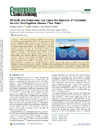Please use this identifier to cite or link to this item:
https://accedacris.ulpgc.es/handle/10553/75411
| DC Field | Value | Language |
|---|---|---|
| dc.contributor.author | Almeda García, Rodrigo | en_US |
| dc.contributor.author | Cosgrove, Sarah | en_US |
| dc.contributor.author | Buskey, Edward J. | en_US |
| dc.date.accessioned | 2020-11-11T13:29:24Z | - |
| dc.date.available | 2020-11-11T13:29:24Z | - |
| dc.date.issued | 2018 | en_US |
| dc.identifier.issn | 0013-936X | en_US |
| dc.identifier.uri | https://accedacris.ulpgc.es/handle/10553/75411 | - |
| dc.description.abstract | After oil spills and dispersant applications the formation of red tides or harmful algal blooms (HABs) has been observed, which can cause additional negative impacts in areas affected by oil spills. However, the link between oil spills and HABs is still unknown. Here, we present experimental evidence that demonstrates a connection between oil spills and HABs. We determined the effects of oil, dispersant-treated oil, and dispersant alone on the structure of natural plankton assemblages in the Northern Gulf of Mexico. In coastal waters, large tintinnids and oligotrich ciliates, major grazers of phytoplankton, were negatively affected by the exposure to oil and dispersant, whereas bloom-forming dinoflagellates (Prorocentrum texanum, P. triestinum, and Scrippsiella trochoidea) notably increased their concentration. The removal of key grazers due to oil and dispersant disrupts the predator–prey controls (“top-down controls”) that normally function in plankton food webs. This disruption of grazing pressure opens a “loophole” that allows certain dinoflagellates with higher tolerance to oil and dispersants than their grazers to grow and form blooms when there are no growth limiting factors (e.g., nutrients). Therefore, oil spills and dispersants can act as disrupters of predator–prey controls in plankton food webs and as indirect inducers of potentially harmful dinoflagellate blooms. | en_US |
| dc.language | eng | en_US |
| dc.relation.ispartof | Environmental science & technology | en_US |
| dc.source | Environmental science & technology [ISSN 0013-936X], v. 52, 10, p. 5718–5724 | en_US |
| dc.subject | 251001 Oceanografía biológica | en_US |
| dc.title | Oil Spills and Dispersants Can Cause the Initiation of Potentially Harmful Dinoflagellate Blooms (“Red Tides”) | en_US |
| dc.type | info:eu-repo/semantics/article | - |
| dc.type | Article | - |
| dc.identifier.doi | 10.1021/acs.est.8b00335 | en_US |
| dc.description.lastpage | 5724 | en_US |
| dc.identifier.issue | 10 | - |
| dc.description.firstpage | 5718 | en_US |
| dc.relation.volume | 52 | en_US |
| dc.investigacion | Ciencias | en_US |
| dc.type2 | Artículo | - |
| dc.description.numberofpages | 7 | en_US |
| dc.identifier.ulpgc | No | en_US |
| dc.contributor.buulpgc | BU-BAS | en_US |
| dc.description.sjr | 2,514 | |
| dc.description.jcr | 7,149 | |
| dc.description.sjrq | Q1 | |
| dc.description.jcrq | Q1 | |
| dc.description.scie | SCIE | |
| item.grantfulltext | open | - |
| item.fulltext | Con texto completo | - |
| crisitem.author.dept | GIR ECOAQUA: Ecofisiología de Organismos Marinos | - |
| crisitem.author.dept | IU de Investigación en Acuicultura Sostenible y Ec | - |
| crisitem.author.orcid | 0000-0002-0090-112X | - |
| crisitem.author.parentorg | IU de Investigación en Acuicultura Sostenible y Ec | - |
| crisitem.author.fullName | Almeda García, Rodrigo | - |
| Appears in Collections: | Artículos | |
WEB OF SCIENCETM
Citations
42
checked on Jun 8, 2025
Page view(s)
142
checked on Aug 10, 2024
Download(s)
561
checked on Aug 10, 2024
Google ScholarTM
Check
Altmetric
Share
Export metadata
Items in accedaCRIS are protected by copyright, with all rights reserved, unless otherwise indicated.
